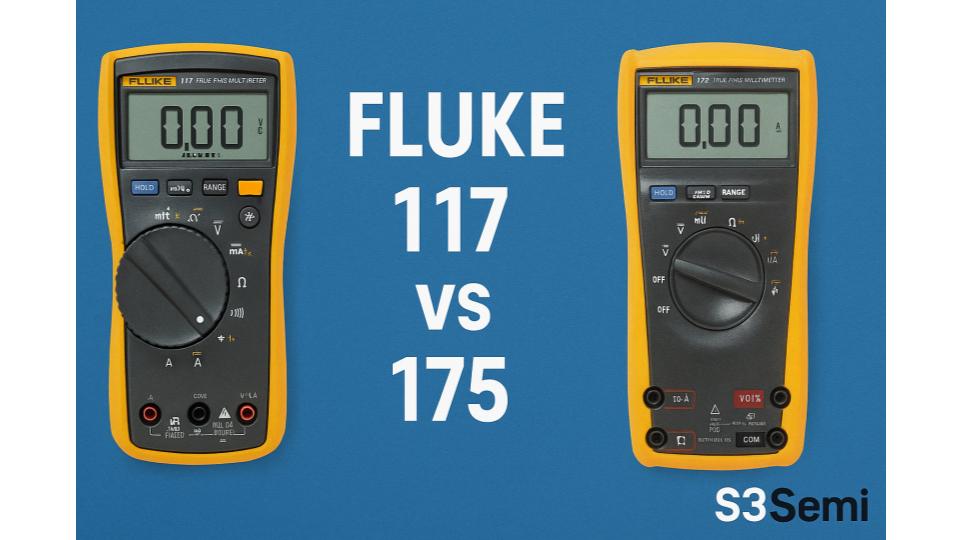Fluke 117 and Fluke 175 are both solid meters from Fluke — but they address subtly different trade-offs. One emphasizes convenience features for field electricians, the other leans into robustness and measurement capability. Below is a detailed breakdown to help you decide which fits your workflow best.
🏷️ Fluke Multimeter Deals ⭐⭐⭐⭐
Overview of the Fluke 117
- Designed primarily for electricians, building maintenance, and field wiring tasks.
- Built-in non-contact voltage detector (VoltAlert) lets you sense live wires without direct contact.
- Auto AC/DC sensing (AutoVolt) reduces mistakes switching ranges.
- True RMS measurements for accurately measuring complex or distorted waveforms.
- Safety rating: CAT III 600 V.
- Compact, ergonomic design with useful daily conveniences.
Overview of the Fluke 175
- A general-purpose true RMS multimeter targeting industrial technicians and mixed use.
- Lacks VoltAlert and AutoVolt — modes are manually selected.
- Emphasis on measurement fidelity, safety ratings, and durability.
- Safety rating: CAT IV 600 V / CAT III 1000 V on input, offering extra margin in harsher environments.
- Solid all-round utility without many of the “extra” features meant for electricians.
⚖️ Side-by-Side Comparison
| Feature | Fluke 117 | Fluke 175 |
|---|---|---|
| Non-contact voltage (VoltAlert) | ✅ Included | ❌ Not included |
| Auto AC/DC selection | ✅ Yes | ❌ Manual only |
| True RMS support | ✅ Yes | ✅ Yes |
| DC voltage accuracy | Moderate | Higher precision in many ranges |
| AC voltage / current ranges | Standard for field work | Broad ranges, robust |
| Safety rating | CAT III 600 V | CAT IV 600 V / CAT III 1000 V |
| Typical user conveniences | Backlight, auto sensing, compact | Rugged build, strong protection |
| Best for | Field electricians, wiring, lighting | Industrial, mixed diagnostics, tougher environments |
| 💳 Pricing | 💲Check Price | 💲Check Price |
Pros and Cons
Fluke 117 — Pros & Cons
Pros
- Useful for electricians: VoltAlert lets you detect live wires without connecting probes.
- AutoVolt (automatic AC/DC switching) reduces errors when selecting ranges.
- True RMS gives better accuracy under non-sinusoidal loads.
- Its form factor and user-friendly features make it a “go to” field meter.
Cons
- Lower safety category compared to the 175 — less margin in high-energy electrical environments.
- Less precision in some DC ranges compared to industrial meters.
- Fewer advanced measurement features (e.g. no external logging, no extended protection).
Fluke 175 — Pros & Cons
Pros
- Elevated safety ratings support usage in more demanding or unpredictable settings.
- Better accuracy in DC ranges and robustness.
- Great all-purpose meter for labs, repair shops, industrial settings.
- Fewer “extras” means fewer things to fail in harsh conditions.
Cons
- No non-contact voltage sensor — you’ll need a separate tool.
- No auto AC/DC — you must remember to set the correct mode.
- Slightly less ergonomic for pure electrician workflow compared to 117.
Which Should You Choose?
- If your work is mostly in building wiring, lighting panels, HVAC, or commercial electrical work, the Fluke 117 is often the more practical tool — its convenience features speed up routine checks, reduce errors, and make your life easier in the field.
- If you find yourself in industrial plants, repair shops, or doing diagnostics across varied electrical systems, the Fluke 175 offers a safer, more precise all‐around tool that can take more abuse and provide more confidence in tougher environments.
- If your budget allows and your work is mixed, owning both isn’t unreasonable: use the 117 for quick everyday tasks, and the 175 when you need extra safety or precision.
Final Thoughts
Neither meter is strictly “better” in all cases — they are optimized for different priorities. The Fluke 117 brings electrician-focused convenience, while the Fluke 175 brings enhanced protection and measurement depth. Match your tool to the job you do most.





